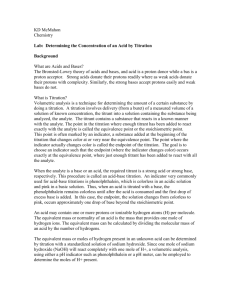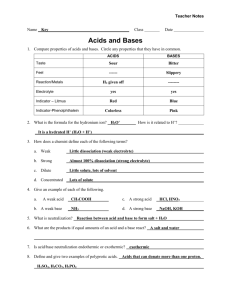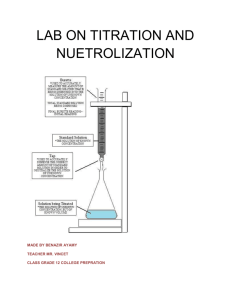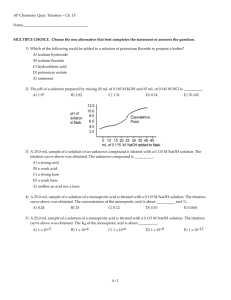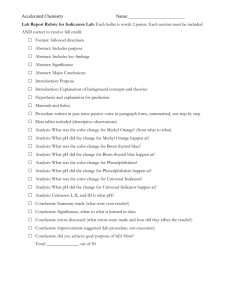Learn Chemistry
advertisement
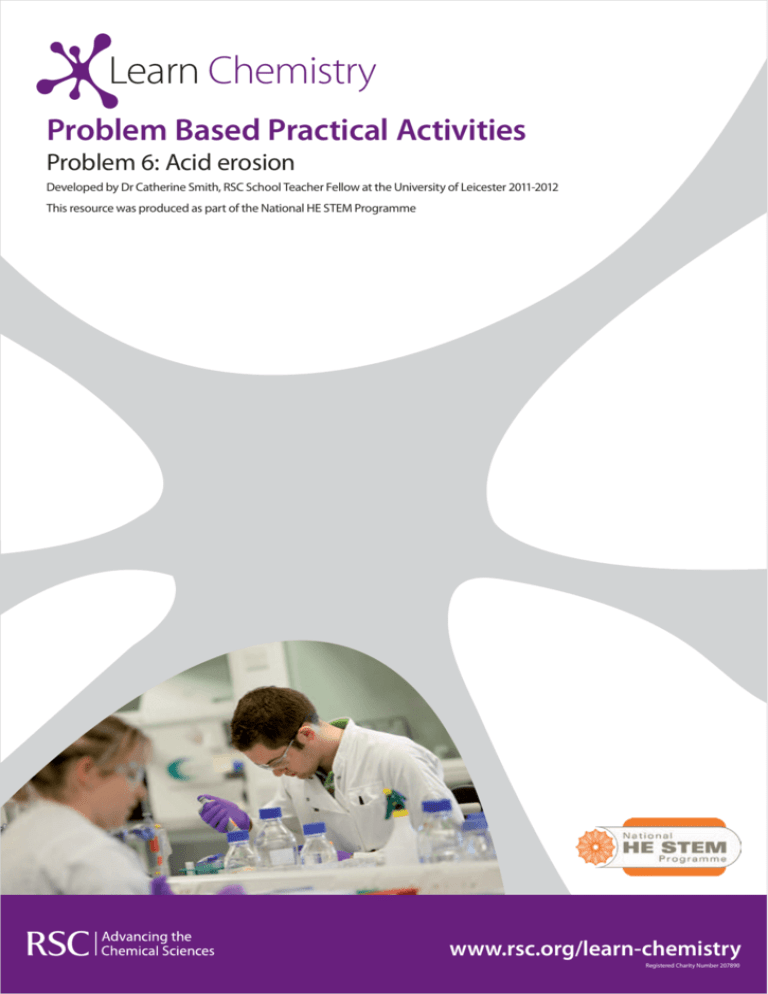
Learn Chemistry Problem Based Practical Activities Problem 6: Acid erosion Developed by Dr Catherine Smith, RSC School Teacher Fellow at the University of Leicester 2011-2012 This resource was produced as part of the National HE STEM Programme www.rsc.org/learn-chemistry Registered Charity Number 207890 Problem 6: Acid erosion Curriculum links; titration, pH curves, strong and weak acids, pKa Practical skills; titration A dentist has contacted the students to determine which of three drinks is the least acidic, and hence which is the least likely to cause tooth enamel erosion. Problem 6: Acid Erosion Pre-Lab questions (Remember to give full references for any information beyond A-level that you find out) 1. White wine, lemonade and orange juice are all known to be acidic. Find out the name and chemical structure of the main acids found in each of the drinks? 2. For each of the acids in question 1, indicate if they are strong or weak acids. For the weak acids give a pKa value for all possible deprotonation sites. 3. Many students get confused when describing the difference between a strong and a weak acid and a concentrated and a dilute acid. Explain the difference as clearly and succinctly as you can. 4. An acid-base titration can be used to determine the concentration of an unknown acid or base. When adding a base to an acid in a titration, the pH changes from acidic (pH < 7) to basic (pH > 7). Sketch the titration curves obtained in the following titrations; a) addition of a strong base to a strong acid b) addition of a strong base to a weak acid c) addition of a weak base to a strong acid d) addition of a weak base to a weak acid 5. In order to correctly identify the exact point of neutralisation, an indicator must change colour quickly in the pH range at which neutralisation occurs. For each of the titrations in question 4 a-d above, indicate a suitable indicator. Problem 6: Acid erosion Problem 6: Acid Erosion Introduction Denby Road Dentist Practice Denby Road Hinckley Leicestershire LE11 3LE Dear scientist, I have recently read two different newspaper reports advising on the effect of acidic drinks on patient’s teeth resulting in the erosion of tooth enamel (White wine rots your st teeth….and brushing makes it worse, Daily Mail, 21 October 2009; Fruit drinks ‘can th be as acidic as vinegar and rot away teeth enamel, dentists say, Daily Mail, 20 May 2012). In order to correctly advise my patients on the best liquids to drink, I would like to be provided with some data on the acid content in some common everyday drinks. Drinks popular with my patients include orange juice, lemonade and white wine. Please provide me with a full report outlining your analysis method, data and conclusions, including an evaluation of the accuracy of your data. I am also somewhat confused between the strength of an acid and its concentration. Is the type of the acid present in the different drinks likely to be important? Any information you can provide to help with my confusion would be much appreciated. Many thanks Dr A. Malgam Problem 6: Acid erosion Teacher and Technician Pack Pre-Lab answers 1. + 2. Lemonade contains predominantly citric acid from the lemons Orange juice contains both citric acid and ascorbic acid (Vitamin C) White wine contains principally tartaric acid and malic acid (although the students may find others) All the acids are weak acids (NOTE In ascorbic acid the proton indicated in red is the acidic proton with a pKa of 4.1. The anion generated is stabilised through the conjugated carbonyl system.) 3. A strong acid is an acid which is fully dissociated in solution. An example is HCl which is fully + – dissociated to H and Cl ions in solution; HCl + – H (aq) + Cl (aq) A weak acid is an acid which is only partially dissociated in solution. An equilibrium is established; e.g. ethanoic acid, CH3COOH + – H (aq) + CH3COO (aq) The concentration of an acid tells us how many moles of acid there are in the solution. The acid can be either a strong or a weak acid. So, for example, you can have a dilute solution of a strong acid e.g. 0.1 M HCl or a concentrated solution of a weak acid e.g. 10 M CH3COOH. Problem 6: Acid erosion 4. and 5. 14 - Strong acid – strong base Either indicator suitable 12 10 - 14 - 12 phenolphthalein 10 - pH 8 - pH 8 - 6- 6- 4- methyl orange 2- 4- Strong acid – weak base Methyl orange as indicator 12 10 - methyl orange Volume of base added 14 - Weak acid – weak base No suitable indicators 12 phenolphthalein 10 - pH 8 - pH 8 - 6- 6- 4- phenolphthalein 2Volume of base added 14 - Weak acid – strong base Phenolphthalein as indicator methyl orange 2- 4- phenolphthalein methyl orange 2Volume of base added Volume of base added Problem 6: Acid erosion –3 At concentrations of 1 mol dm or above, sodium hydroxide is corrosive and will cause severe eye damage. Goggles must be worn when it is in use. Teacher and Technician Pack Proposed method Using the pre-lab questions, students realise that a titration with a strong base using phenolphthalein as indicator is required. In order to decide on a suitable concentration for the base, students roughly determine the approximate volumes of the three bases needed to neutralise the acids in the drinks From the results, the students conclude that the most appropriate base for the titration is; = 0.1 M NaOH Students accurately determine the amount of acid in each of 3 the drinks by titrating a 25 cm aliquot of each drink against a 0.1 M solution of NaOH [Irritant] of known concentration, using phenolphthalein [Highly flammable; Harmful] as indicator. Drink White wine Orange juice Lemonade Average titre / 3 cm 22.95 33.75 17.20 Using the results of the titration together the pKa values of the acids in each of the drinks found in the pre-lab questions, students make a recommendation to the dentist. Problem 6: Acid erosion Teacher and Technician Pack Equipment list See the Health and safety guidance section in the Introduction for more general information on risk assessments and a key to the health and safety symbols used. Each group will need; Initial investigations; Access to NaOH of varying concentrations (0.1 M [Irritant]; 1 M [Corrosive]; 2 M [Corrosive]). Approximate concentrations are adequate‡ 3 3 × 10 cm measuring cylinder Phenolphthalein indicator [Highly flammable; Harmful] 3 Samples of orange juice, lemonade and white wine (30 cm samples of each) 3 3 × 100 cm conical flask Disposable pipettes 3 3 3 ‡ Each group should only need approx 50 cm of 0.1 M NaOH, 10 cm of 1 M NaOH and 5 cm of 2 M NaOH in total if 3 they try and neutralise the acid in 10 cm samples of each of the drinks Accurate titration; 0.1 M NaOH of known, accurate concentration [Irritant]† 3 125 cm White wine 3 125 cm Lemonade (opened several days previously to allow all the CO2 to come out of solution) 3 125 cm Orange juice Phenolphthalein indicator [Highly flammable; Harmful] If the group is to split up the work load and analyse the acid content in one drink each, each group will need 3 of each of the following; 3 50 cm burette* Funnel Burette stand and clamp 3 25 cm volumetric pipette with pipette filler* 3 250 cm conical flask White tile Distilled water 3 250 cm beaker (for the NaOH) * The equipment must either be labelled with its accuracy or the information provided separately. † If the titration is carried out on 25 cm samples of drink, the approximate titres are; white wine 23 cm ; orange juice 3 3 34 cm ; lemonade 17 cm (although this will vary with exact origin of drink) 3 3 3 3 For the titration, each student group will therefore need access to 150 cm of each drink and 600 cm of 0.1 M NaOH of known concentration (allowing for washing etc). Problem 6: Acid erosion



